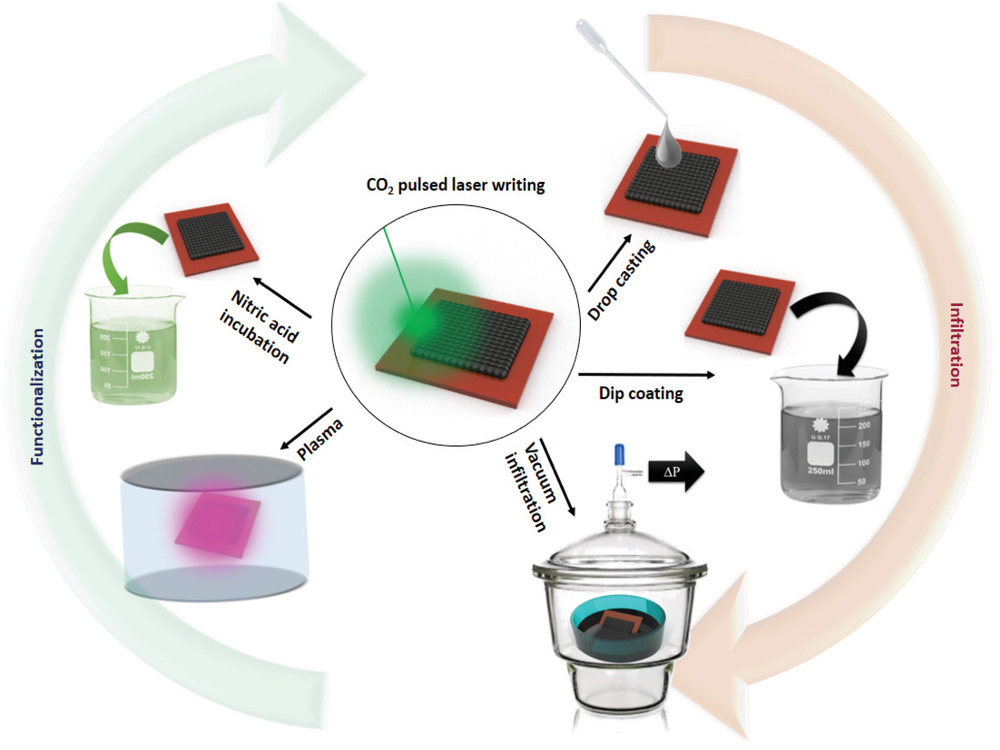
Author(s): M. Reina, A. Scalia, G. Auxilia, M. Fontana, F. Bella, S. Ferrero, A. Lamberti
Published in: Advanced Sustainable Systems, 2022, ISSN 2366-7486
Publisher: Wiley-VCH GmbH
DOI: 10.1002/adsu.202100228
Abstract: Laser-induced graphene (LIG) is under the spotlight as a promising material for flexible supercapacitors due to its simple processing and flexibility. However, the poor conductivity and the reduced surface area have prompted research to improve its performance, traditionally introducing a pseudocapacitive behavior. Herein an effective yet easy way is presented to dramatically improve the electric double layer capacitance of LIG electrodes for supercapacitor-related applications without the occurrence of redox reactions. The strategy simply relies on the exploitation of an LIG network to trap and interconnect activated carbon (AC) particles. In order to optimize the infiltration of AC into LIG porosities, several strategies are tested, both varying the surface wettability of LIG and acting on the impregnation approach. Overall, the best compromise results in the combination of LIG N-doping by nitric acid incubation with vacuum-assisted infiltration of an AC-slurry, allowing a two-order of magnitude improvement in the specific capacitance up to 20 mF cm−2 in device configuration.
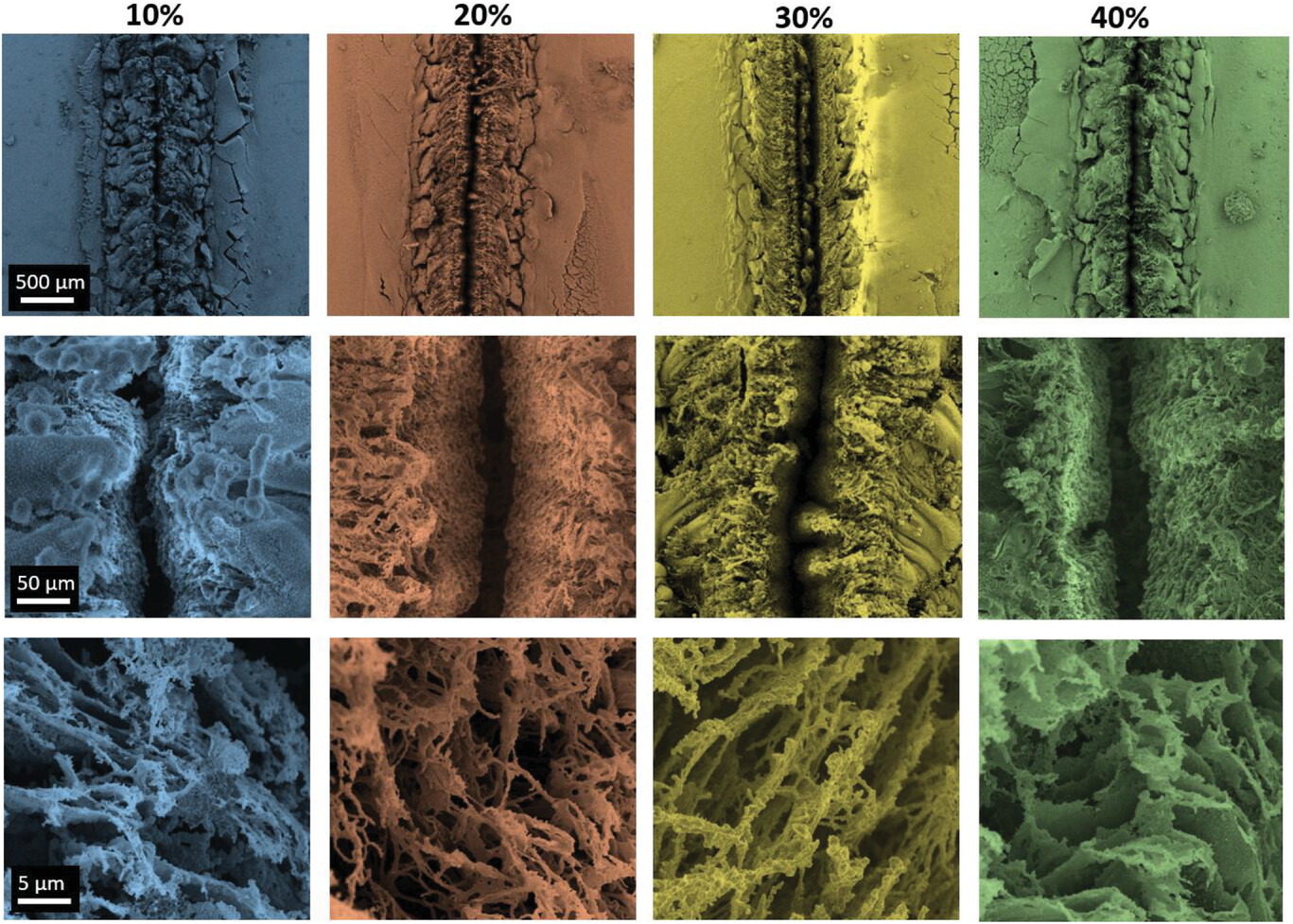
Author(s): P
. Zaccagnini, C. Ballin, M. Fontana, M. Parmeggiani, S. Bianco, A. Pedico, S. Ferrero, A. Lamberti
Published in: Advanced Materials Interfaces, 8, 2021, Page(s) 2101046, ISSN 2366-7486
Publisher: Wiley-VCH GmbH
DOI: 10.1002/admi.202101046
Abstract:
Laser graphenization of polymeric surfaces has emerged as one of the most promising technologies to fabricate flexible electrodes. Unfortunately, despite the large number of materials suitable for laser-induced graphene (LIG) fabrication, there is a lack of stretchable polymers, hindering the full exploitation of LIG for flexible electronics. Herein, the laser graphenization of polydimethylsiloxane (PDMS), the most exploited elastomeric substrate for flexible electronic device fabrication, is proposed for the first time. The low carbon content and the absence of aromatic structures strongly limit the graphenization process resulting in limited conduction properties. Nevertheless, by adding triethylene glycol (TEG) as carbon source into the PDMS matrix, it is possible to improve the graphenization and to reduce the sheet resistance of the written LIG by two orders of magnitude down to 130 ohm sq−1. The PDMS-TEG material becomes a suitable candidate for flexible microsupercapacitor fabrication with specific capacitance values as high as 287 µF cm−2 and energy and power density approaching LIG-based supercapacitors fabricated onto traditional polyimide substrates.
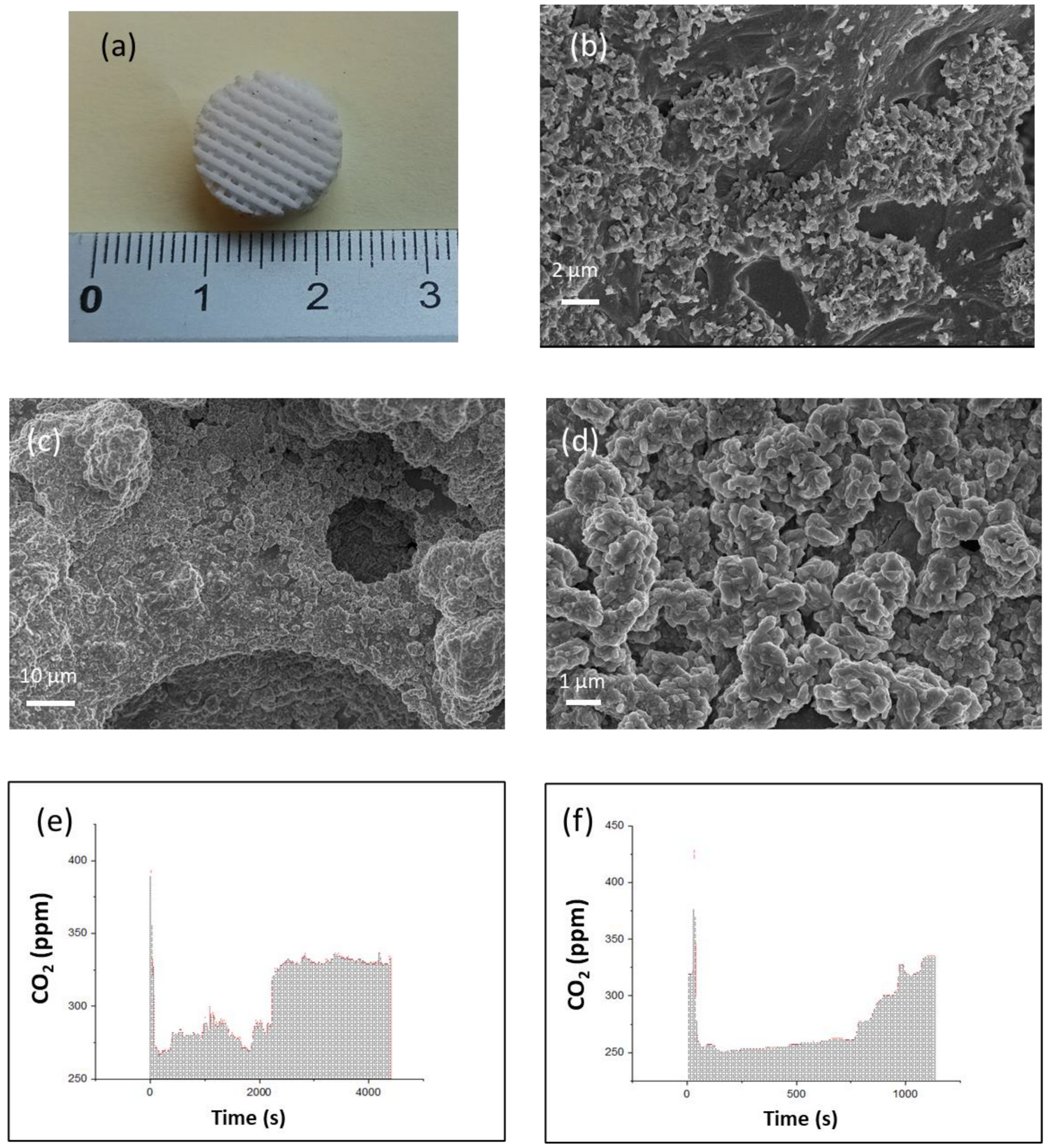
Author(s):
Chiappone, A.; Pedico, A.; Porcu, S.; Pirri, C. F.; Lamberti, A.; Roppolo, I.
Published in:
Polymers 2022, 14, 5265
Publisher:
MDPI
DOI:
10.3390/polym14235265
Abstract:
Porous organic polymers are versatile platforms, easily adaptable to a wide range of applications, from air filtering to energy devices. Their fabrication via vat photopolymerization enables them to control the geometry on a multiscale level, obtaining hierarchical porosity with enhanced surface-to-volume ratio. In this work, a photocurable ink based on 1,6 Hexanediol diacrylate and containing a high internal phase emulsion (HIPE) is presented, employing PLURONIC F-127 as a surfactant to generate stable micelles. Different parameters were studied to assess the effects on the morphology of the pores, the printability and the mechanical properties. The tests performed demonstrates that only water-in-oil emulsions were suitable for 3D printing. Afterwards, 3D complex porous objects were printed with a Digital Light Processing (DLP) system. Structures with large, interconnected, homogeneous porosity were fabricated with high printing precision (300 µm) and shape fidelity, due to the addition of a Radical Scavenger and a UV Absorber that improved the 3D printing process. The formulations were then used to build scaffolds with complex architecture to test its application as a filter for CO2 absorption and trapping from environmental air. This was obtained by surface decoration with NaOH nanoparticles. Depending on the surface coverage, tested specimens demonstrated long-lasting absorption efficiency.
Author(s): F. Raffone
, A. Lamberti, G. Cicero
Published in:
Electrochimica Acta 2023, 458, 142344, ISSN
0013-4686
Publisher: Elsevier
DOI:
10.1016/j.electacta.2023.142344
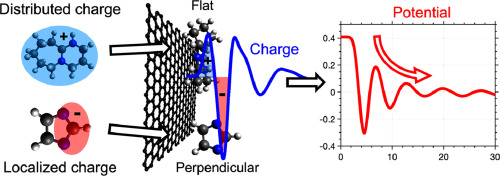
Abstract:
Ionic liquids (ILs) have been extensively employed in many applications involving interfaces with carbon-based electrodes, such as energy storage devices (batteries or supercapacitors) or electrocatalytic devices, where the way each ion of the IL interacts with the electrode has a strong impact on the overall performance of the device. For instance, the amount of potential difference between the electrode and the bulk of the IL is highly sensitive to the IL composition and it is directly related to the device capacitance. The selection of the most suited pair of ions often proceeds by time-consuming and costly trial-and-error approaches. It is necessary to understand the atomistic features of the interface to determine the effect of each ion on the potential drop. By classical molecular dynamics simulations, we show that it is possible to quickly infer the interface potential arising at the carbon electrode by carefully inspecting the molecular structure of the IL. The ion orientation at the interface is, in fact, determined by the distribution of charges within the molecules. Depending on where charges are located, ions can either lie flat or perpendicular to the interface to minimize the surface energy. The interface potential is found to be mainly determined by ion–ion interactions dictating the interface energy minimization process, whereas ion–electrode interactions are found to enforce higher ordering and charge layers stacking but not to induce selective adsorption of an ion over the other.
Author(s): D. Molino, A. Pedico, P. Zaccagnini, S. Bocchini, A. Lamberti
Published in:
Electrochimica Acta 2023, 468, 143143, ISSN
0013-4686
Publisher: Elsevier
DOI:
10.1016/j.electacta.2023.143143
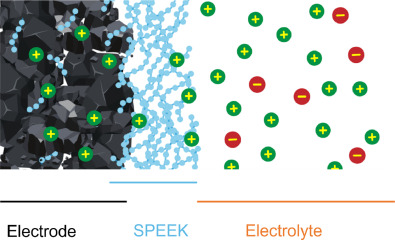
Abstract:
In this work we report a green procedure for the infiltration of a SPEEK solution into a porous carbon electrode resulting in a thin-film cation exchange membrane. The electrodes have been investigated by a morphological point of view, showing the formation of a thin coating infiltrated into the porous carbonaceous matrix, while mechanical peeling of a tape demonstrated the adhesion of the proposed layer. The fabricated electrodes have been analyzed by electrochemical measurement. The 3-electrode cyclic voltammetry measurements allowed to verify the voltage window resulting in an improved negative potential, while the electrochemical impedance spectroscopy showed a reduction of the electrical resistance. The SPEEK electrode was used in a supercapacitor and deeply characterized by electrochemical analysis. The reported findings demonstrate for the first time the possibility to exploit a cation exchange material in thin film configuration for supercapacitor application with improved performance of the device and exclusively involving the use of nontoxic reagents.
Author(s): M. Reina, M. Serrapede, P. Zaccagnini, A. Pedico, M. Castellino, S. Bianco, T. Ouisse, H. Pazniak, J. Gonzalez-Julian, A. Lamberti
Published in:
Electrochimica Acta 2023,
468, 143163
Publisher: Elsevier
DOI:
10.1016/j.electacta.2023.143163

Abstract:
During the last years, Internet of Things has become a prominent topic of technical, social, and economic importance. One of the main consequences is the high demand for energy and power density from small energy storage devices. In this field the laser induced graphene (LIG) has become a promising material to produce flexible micro-supercapacitors. The issue with this material is that the performances are strongly restrained by its limited surface area and the relatively low conductivity. In this work we improve the performance of a LIG supercapacitor by decorating its surface through electrophoresis: one electrode will be decorated with metal nitrides and metal carbides (MXenes), the other with manganese oxide. These two materials have appreciable conductivity and pseudocapacitance. Electrochemical measurements have been carried out on the two electrodes separately. After a charge balancing, the device has been sealed in pouch and tested.
Author(s): P. Zaccagnini, Y. Tien, L. Baudino, A. Pedico. S. Bianco, A. Lamberti
Published in:
Advanced Materials Technology 2023, 8 (23), 2300833
Publisher: Wiley
DOI:
10.1002/admt.202300833

Abstract:
Microsupercapacitors (µSCs) have received a lot of interest for their possible use in miniaturized electronics and in the field of the Internet of Things (IoT) to power distributed sensors. µSCs fill the gap between batteries and traditional capacitors, providing high power densities and acceptable energy densities to fulfill onboard power supply requirements, coupled with quick charge/discharge rates and extended lifetime. Charge balancing of µSCs is not a standard practice, although the optimization of electrodes can provide beneficial effects on the electrochemical performance and stability of the device. In this work, a charge-balanced double-layer µSC based on laser-induced graphene (LIG) with [PYR14][TFSI] as an ionic liquid electrolyte is presented for the first time. The optimized device shows an improvement in terms of the increased lifetime of a factor of four and its energy efficiency is raised above 80%.

Author(s): G. Mogli,
M. Reina, A. Chiappone, A. Lamberti, F.C. Pirri. I. Roppolo, S. Stassi
Published in:
Advanced Functional Materials 2023, 34 (7), 202307133
Publisher: Wiley
DOI:
10.1002/adfm.202307133
Abstract:
Self-healing ionic conductive hydrogels have shown significant potential in applications like wearable electronics, soft robotics, and prosthetics because of their high strain sensitivity and mechanical and electrical recovery after damage. Despite the enormous interest in these materials, conventional fabrication techniques hamper their use in advanced devices since only limited geometries can be obtained, preventing proper conformability to the complexity of human or robotic bodies. Here, a photocurable hydrogel with excellent sensitivity to mechanical deformations based on a semi-interpenetrating polymeric network is reported, which holds remarkable mechanical properties (ultimate tensile strain of 550%) and spontaneous self-healing capabilities, with complete recovery of its strain sensitivity after damages. Furthermore, the developed material can be processed by digital light processing 3D printing technology to fabricate complex-shaped strain sensors, increasing mechanical stress sensitivity with respect to simple sensor geometries, reaching an exceptional pressure detection limit below 1 Pa. Additionally, the hydrogel is used as an electrolyte in the fabrication of a laser-induced graphene-based supercapacitor, then incorporated into a 3D-printed sensor to create a self-powered, fully integrated device. These findings demonstrate that by using 3D printing, it is possible to produce multifunctional, self-powered sensors, appropriately shaped depending on the various applications, without the use of bulky batteries.
Author(s): Z. Xu,
G. Mapstone, Z. Coady, M. Wang, T. L. Spreng. X. Liu, D. Monilo and A.C. Forse
Published in:
Nature Communications volume 15, Article number: 7851 (2024)
Publisher: Nature
DOI:
10.1038/s41467-024-52219-3

Abstract:
Supercapacitors are emerging as energy-efficient and robust devices for electrochemical CO2capture. However, the impacts of electrode structure and charging protocols on CO2 capture performance remain unclear. Therefore, this study develops structure-property-performance correlations for supercapacitor electrodes at different charging conditions. We find that electrodes with large surface areas and low oxygen functionalization generally perform best, while a combination of micro- and mesopores is important to achieve fast CO2capture rates. With these structural features and tunable charging protocols, YP80F activated carbon electrodes show the best CO2 capture performance with a capture rate of 350 mmolCO2 kg–1 h–1 and a low electrical energy consumption of 18 kJ molCO2–1 at 300 mA g–1under CO2, together with a long lifetime over 12000 cycles at 150 mA g–1 under CO2 and excellent CO2 selectivity over N2 and O2. Operated in a “positive charging mode”, the system achieves excellent electrochemical reversibility with Coulombic efficiencies over 99.8% in the presence of approximately 15% O2, alongside stable cycling performance over 1000 cycles. This study paves the way for improved supercapacitor electrodes and charging protocols for electrochemical CO2 capture.
Author(s):
P. Prete, S. Trano, P. Zaccagnini, L. Fagiolari, J. Amici, A. Lamberti, A. Proto, F. Bella, and R. Cucciniello
Published in:
ChemSusChem
2024, 17, e202401636
Publisher: Wiley
DOI:
10.1002/cssc.202401636

Abstract:
Considering the worldwide market of batteries and supercapacitors, the (partial or total) replacement of conventional fossil-derived carbonates with bio-based ones in electrolyte formulations would allow the production of safer and more sustainable devices. In this work, embracing the 7th principle of green chemistry, glycerol derivatives (namely glycerol carbonate and solketal carbonate) are tested as solvents and additives for electrolyte formulations. Glycerol carbonate is innovatively employed as promising electrolyte solvent for electric double-layer capacitors with excellent performances. On the other hand, a solketal carbonate-laden liquid electrolyte is investigated for potassium-based batteries, showing a rather stable electrochemical behaviour and performance close to those of commercial oil-derived alternatives.
Author(s):
A. Pedico, D. Molino, P. Zaccagnini, S. Bocchini, V. Bertana, and A. Lamberti
Published in:
Adv. Sustainable Syst.
2024, 8, 2400106
Publisher: Wiley
DOI:
10.1002/adsu.202400106

Abstract:
This work investigated the possibility of using functionalized graphene oxide and sulfonated poly(ether ether ketone) coatings on activated carbons to obtain an asymmetric device suitable for Capacitive Mixing (CapMix) application. Herein the synthesis and fabrication procedures of both materials and electrodes are reported, together with a comprehensive list of electrochemical characterization techniques. The results from the electrochemical characterization are used to design the optimal operational parameters for CapMix experiments involving the materials being studied. A homemade cell is designed and fabricated for CapMix application by polymer micromachining. Electrochemical tests are conducted to optimize the process parameters and the results of this optimization are reported, proving that both the materials and the process parameters play a key role in CapMix. The final device can generate a net power output of 12 mW m−2 by mixing simulated seawater and freshwater. This result paved the way for further application of graphene oxide in the field of renewable energy.

Author(s):
D. Molino, G. Ferraro, S. Lettieri, P. Zaccagnini, M. Etzi, C. Astorino, E. De Nardo, M. Bartoli, A. Lamberti, C. F. Pirri, and S. Bocchini
Published in:
Adv. Sustainable Syst.
2024, 8, 2400415
Publisher: Wiley
DOI:
10.1002/adsu.202400415
Abstract:
A novel potentiometric sensor for carbon dioxide (CO2) detection utilizing a composite membrane of Polymer of Intrinsic Microporosity (PIM-1) and 18-diazabicyclo[5.4.0]undec-7-ene imidazolate (DBU-imidazolate) is presented. The high surface area and gas permeability of PIM-1, combined with the chemical affinity and ion-exchange properties of DBU-imidazolate, contribute to enhanced CO2 sensitivity and selectivity. The research objectives included the synthesis of PIM-1 and DBU-imidazolate, the preparation of composite membranes, and the evaluation of their performance as CO2 sensors. Solvent casting and impregnation methods are employed to prepare the membranes, which are characterized using Thermal Gravimetric Analysis (TGA), and Field Emission Scanning Electron Microscopy (FESEM). CO₂ absorption tests and Electrochemical Impedance Spectroscopy (EIS) are conducted to assess the sensors' performance. The PIM-1/DBU-imidazolate membrane exhibited high efficiency in CO₂ capture and release. Open circuit voltage (OCV) measurements are performed under varying concentrations of CO2exposure and cycles of adsorption/desorption. Results show that the membrane achieves steady state faster at higher CO2 concentrations, with a logarithmic relationship between CO2 concentration and voltage variation, indicating potential for CO2 detection in human environments. These results confirm the sensor's ability to detect varying CO2concentrations, highlighting its potential for reliable and efficient CO2 monitoring in environmental and industrial applications.
Author(s):
L. Baudino, P. Zaccagnini, S. Bianco, M. Castellino, A. Lamberti, C. F. Pirri, and M. Serrapede
Published in:
ChemCatChem
2025, 17, e202401689
Publisher: Wiley
DOI:
10.1002/cctc.202401689

Abstract:
Titanium dioxide nanotubes (TiO2 NTs) have been widely investigated in the past 20 years due to a variety of possible applications of this material. Indeed, their high surface area and tunable morphology can easily implement key features of TiO2, such as its biocompatibility and photo- and electrocatalytic properties. This combination makes TiO2NTs perfect candidates for multifunctional applications ranging from biomedical application to sensing and energy devices. Herein, we present TiO2 NTs grown by anodic oxidation on top of a titanium foil in an ethylene glycol-based electrolyte with NH4F. The as-grown amorphous nanotubes were then subjected to annealing in a reducing atmosphere at different temperatures while maintaining their amorphicity. The morphological, physicochemical, and electronic properties were then thoroughly evaluated to assess their use in different fields, from energy storage devices to photo-catalytical applications.














